![]()
![]()
![]()
Use LEFT and RIGHT arrow keys to navigate between flashcards;
Use UP and DOWN arrow keys to flip the card;
H to show hint;
A reads text to speech;
34 Cards in this Set
- Front
- Back
|
Minimum Viable Population
pg 248 |
MVP. The number of individuals necessary to ensure the long-term survival of a species.
Smallest isolated population having a 99% chance of remaining for 1000 years. |
|
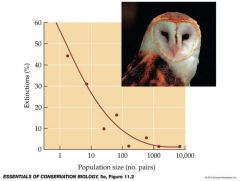
|
Population Size v. Extinction Rates
|
|
|
Predicted MVP for most populations?
pg 249 |
100 or over.
<50 die off within 50 years. |
|
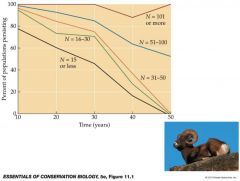
|
Minimum Viable Population size
|
|
|
Minimum Dynamic Area
pg 250 |
MDA. Area of suitable habitat necessary for maintaining the MVP
|
|
|
3 Main reasons small populations are subject to rapid decline and local extinction:
|
1) Loss of genetic variability and related issues to inbreeding and genetic drift
2) Demographic fluctuations due to random variations in birth and death rates 3) Environmental fluctuations due to variation in predation, competition, disease, food supply and due to natural catastrophe. |
|
|
Alleles
pg 250 |
Different forms of the same gene
New alleles arise due to mutations or through migration of individuals from other populations. |
|
|
Genetic Drift
pg 251 |
Random process of allele frequency change.
Genetic variability is lost randomly over time through genetic drift. Low frequency alleles in a small populations have a significant probability of being lost in each generation. |
|
|
Effective Population Size
pg 251 |
Size of the population as estimated by the number of its breeding individuals
(Ne) |
|
|
Formula for proportion of Heterozygosity remaining after each generation
pg 251 |
Generation- H
Effective Population Size- Ne H= 1- 1/( 2 Ne) Example: Population of 50 breeding indivs 1-1/(2*50) 1-1/100 1-.01=.99 99% An effective population size of 50 would retain 99% of its heterozygosity. |
|
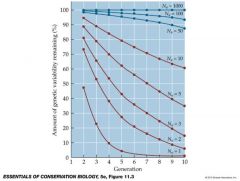
|
Genetic Variability Lost
|
|
|
Ht=Ht
pg 251 |
Take H from Heterozygosity equation andmultiply it by itself, this if the amount of retained heterzygosity after 2 generations
|
|
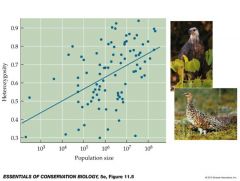
|
Heterozygosity of small v. large populations
|
|
|
Mutation Rates in Nature
pg 251 |
1 in 1 mil/gene/generation
|
|
|
50/500 Rule
pg 254 |
Isolated populations Need at Least 50 indivs and Preferably 500 to maintain genetic variability.
Empirical studies show that Actually several thousand individuals must be protected to maintain variability. |
|
|
Inbreeding
pg 254 |
Mating among close relatives
|
|
|
Outbreeding
pg254 |
Mating with organisms outside of population or species
|
|
|
Inbreeding Depression
pg 254 |
When an individual receives two identical copies of a defective allele. Characterized by higher mortality, fewer offspring or weak or sterile offspring
|
|
|
Outbreeding Depression
pg 255 |
When organisms cant find a mate within their own species or population, may mate with "related" individuals of another species.
Results in weakness, sterility or lack of adaptability with environment. (incompatibility of the chromosomes) |
|

|
Relatedness v. Fitness
|
|
|
Hybrid Vigor
pg 255 |
When outbreeding produces a More vigorous species
|
|
|
Loss of genetic variability limits a small population's ability to...
pg257 |
respond to new conditions and longterm changes
|
|
|
Unequal sex ratio
pg258 |
When the numbers of mating males and females are unequal
Ne=[4(NfxNm)]/(Nf+Nm) Nf-breeding females Nm-breeding males Ne-effective pop size |
|
|
Population flucuations and Bottlenecks equation
pg259 |
Effective pop size can be calculated over a period of years using number of indivs
Ne=t/(1/N1+1/N2+1/N3.....1/N8) Ne-effective population size t-years N- breeding individuals |
|
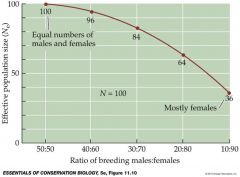
|
effective population size in unequal sex ratio
|
|
|
Population bottleneck
pg 260 |
when a population is greatly reduced in size and loses its rare alleles
|
|
|
Founder effect
pg260 |
When a few individuals leave one pop to establish another new pop. 2nd pop has less genetic variability than the original
|
|
|
Stochasity
pg264 |
Random Variation
|
|
|
Environmental Stochasity
pg 264 |
Random variation in Biological and Physical environment, can also cause vriation in the pop size.
|
|
|
Demographic Stochasity
pg 264 |
Variation in Birth and Death rates among individuals and across years within a given pop
|
|
|
Allee effect
pg265 |
Small populations are demographically unstable because social interactions can be disrupted once a pop density falls below a certain level.
The interaction between pop size, pop density and pop growth rate. |
|
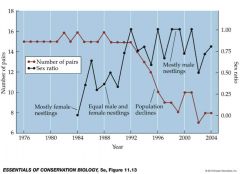
|
Sex Ratios decline in a stressed environment
|
|
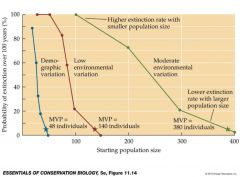
|
Extinction Rate V Population size
Effects of demographic variation, low environmental variation, and moderate environmental variation and the probability of extinction |
|
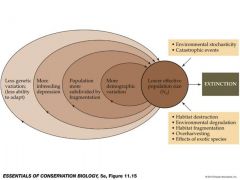
|
Extinction Vortex
|

